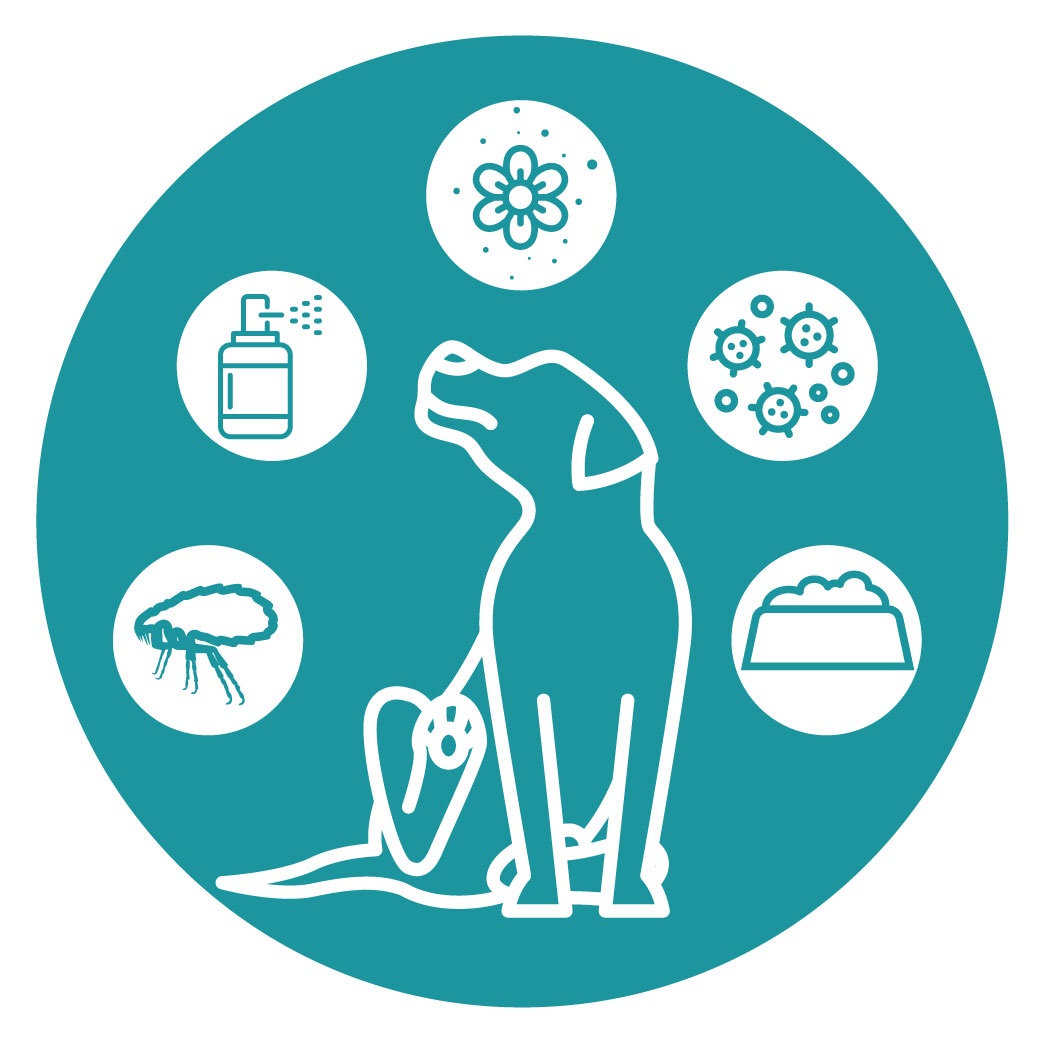German Shepherd Dog

German Shepherd Dog
Congenital Predispositions of the German Shepherd GSD:
The German Shepherd is a breed of medium to large-sized working dog that originated in Germany. In the English language, the breed’s officially recognized name is German Shepherd Dog (GSD). The breed was officially known as the Alsatian in the UK from after the First World War until 1977 when its name was changed back to German Shepherd.
As a herding dog, German Shepherds are working dogs developed originally for herding sheep. Since that time, however, because of their strength, intelligence, trainability, and obedience, German Shepherds around the world are often the preferred breed for many types of work, including, disability assistance, search-and-rescue, police and military roles as well as acting.
Degenerative Myelopathy (DM):
DM is a progressive and fatal degenerative disease of the spinal cord caused by a gene mutation. It is thought to be caused by excessive amounts of Reactive Oxygen Species Molecules (ROS) causing oxidative or free radical injury.
Degeneration of the outer layer of tissue of the spinal cord – white matter, in the thoracic section of the spine, over time leads to complete paralysis of all limbs known as tetraplegia. This is a chronic and fatal condition that has no effective treatment.
Classic signs of DM are seen at roughly 8 to 9 years of age, but it has been reported in dogs as young as 6 months. It involves hindlimb ataxia (uncoordinated and wobbly), which progresses to hindlimb weakness (paresis) with an inability to stand and then to complete hindlimb paralysis. If allowed to progress, it will travel up the spinal cord and affect the forelimbs, leading to tetraplegia.
Even though this is considered a non-painful condition, it can be extremely distressing for the dog, particularly as their mobility decreases. It requires high nursing care and commitment from the owners, as through the progression normal urine and faecal control will be lost. Pressure sores and ulcers are also a risk so attention to their needs is paramount. Despite the lack of effective treatments, physiotherapy in the early stages can help them stay mobile for longer. Owners usually opt for euthanasia before it progresses to tetraplegia.
Gene testing is available to identify animals at risk of developing DM or those that are carriers.
Hemangiosarcoma:
Hemangiosarcoma is an aggressive form of cancer in dogs. It develops from the cells that normally create blood vessels (endothelial cells) so it can be found anywhere in the body. It is commonly found in the spleen, but also the liver, heart, skin, bones and central nervous system. Due to the aggressive behaviour, it can spread regionally and distantly.
There are very few signs of the cancer until an acute bleeding event occurs, resulting in collapse, pale mucous membranes, cardiovascular effects and haemoabdomen/pericardial effusion (blood in the abdomen/pericardium).
At this point surgery is indicated to control the bleeding, address the associated clinical signs related to blood loss, remove infiltrated masses or organs, and to obtain a definitive diagnosis.
Occasionally, this cancer may be detected incidentally on radiographs, ultrasound, or echocardiogram; however, on review of recent history, signs of transient lethargy and weakness are frequently noted.
Presentations involving the skin/subcutaneous/intramuscular tissues typically manifest as progressive masses that are appreciated externally. Those affecting the bone exhibit signs of bone pain associated with radiographic bone lesions. In most cases, tissue biopsy is needed to definitively diagnose hemangiosarcoma, as other benign and malignant causes can cause similar abnormalities.
Staging tests recommended to define extent of disease include blood work, urinalysis, coagulation profile, thoracic/abdominal imaging, and echocardiogram.
Staging for hemangiosarcoma is based on the Tumour, Node, Metastasis (TNM) system as follows:
Stage I: No evidence of neoplasia (typically achieved post operatively) or associated with a tumour <5 cm, confined to the primary site with no regional/distant metastasis.
Stage II: Tumour <5 cm or greater than or equal to 5 cm in diameter, that is either confined to the primary site, ruptured (haemoabdomen/pericardial effusion), or invading subcutaneous tissue with evidence of regional lymph node involvement, with evidence of distant disease spread.
Surgery is the primary treatment to address intra-abdominal masses, right auricular appendage masses, subcutaneous/intramuscular masses, and bone lesions. This is preferably done before the mass or masses rupture and the patient is stable. Unfortunately, with those presentations associated with liver and splenic disease, surgery often has to be done when the patient is in a critical state.
Other modes of treatment include radiation therapy, chemotherapy, immunotherapy and metronomic chemotherapy.
The prognosis associated with almost all presentations of hemangiosarcoma, with the exception of primary cutaneous hemangiosarcoma, is considered poor.
Prognosis for the most common form – Splenic Hemangiosarcoma, if surgery alone is pursued, irrespective of stage at time of diagnosis, the anticipated median survival time is approximately ~2-4 months. The addition of chemotherapy as adjuvant to surgery when only microscopic disease is present is associated with a more favourable outcome.
Elbow Dysplasia:
Dysplasia literally means “abnormality of development”. The elbow joint is complex because it involves the articulation of 3 bones, and if they do not fit together perfectly because of abnormal development, the consequence is an abnormal concentration of force on a specific region of the joint.
Elbow dysplasia is a common cause of forelimb lameness in young, large and giant breed dogs. Obesity in puppyhood increases the risks that a gene carrier will develop a clinical problem in their life.
Dogs can present with forelimb lameness, stiff with elbow pain in one or both legs, and should be suspected as elbow dysplasia with any of these symptoms when not associated with an acute trauma.
Elbow dysplasia can cause Osteoarthritis but is also associated with discrete pathological fractures within the joint.
Diagnosis through examination and imaging, whether that be radiographs, CT or MRI.
Non-surgical treatments include weight management, physiotherapy, exercise modification and medications to address the accompanying pain such as NSAIDs (anti-inflammatory drugs).
There are many different approaches to surgery dependent on the specifics of the individual case, OA or fracture involvement. Surgical treatments for elbow dysplasia aim to treat the current source of pain and to minimise the progression of osteoarthritis.
Gastric Dilatation and Volvulus (GDV) or Bloat:
A common ailment among German Shepherds is bloat, or Gastric Dilatation and Volvulus (GDV). In its early stage, the stomach fills with gas, causing a simple gastric dilatation or bloat. Sometimes, the condition progresses no further than a bloat. A GDV is a progression of the bloat into a volvulus, in which the huge, gas-filled stomach twists upon itself so that both the entrance and exit of the stomach become occluded, blocking the escape of gas, liquids and stomach contents. This build-up of gas and liquid causes the stomach to expand like a balloon (dilatation).
It’s not just the passage of gas and liquid from the stomach that’s altered in GDV, it’s also the blood flow to and from the stomach, as well as throughout the rest of the body (including to and from the heart), that’s severely compromised. The severely bloated stomach can also cause breathing issues and a host of serious metabolic problems — such as acid-base and electrolyte imbalances, blood clotting abnormalities, and widespread inflammation.
Patients typically present with non-productive vomiting or dry heaving, they may bring up small amounts of water or large volumes of viscous stringy saliva. Restlessness – anxious and pacing unable to get comfortable. They may salivate excessively, have difficulty breathing or an increased respiratory effort or rate. Rapid Heart rate, pale mucous membranes and even collapse. Left untreated, GDV is fatal.
Abdominal distension and discomfort, although a distended abdomen may not always be noticeable due to the dog’s conformation, as in deep chested dogs the area of the abdomen where a distended abdomen resides may be up behind the ribcage. Being long haired or overweight may also disguise a bloated abdomen. Not all GDVs have an obvious bloat!
Factors suspected to increase the risk of GDV:
Large deep chested breeds, feeding one meal a day, eating rapidly, feeding a dry diet, exercising immediately after a meal. It is also more prevalent in older dogs 7 to 12 years old and males seem to be at a higher risk.
Precautionary measures are advised to reduce risks such as: feeding a wet diet, feeding smaller meals more often – at least twice daily, and no exercise for several hours after a meal. Fast eaters may need some modification to the way they’re fed such as calming techniques for food related anxieties or tools such as slow feeders.
Abdominal x-rays are the most reliable way to assess stomach position and diagnose bloat. Stabilization of the patient and diagnostics must be performed immediately. Surgical intervention is a necessary step in the treatment of bloat and should be done as soon as the patient is stable enough to undergo anaesthesia and surgery. Surgery requires de-rotation of the stomach facilitated by decompression of the bloat, assessment of surrounding tissues due to loss of blood flow and will also require a Gastropexy which involves the adhesion of the stomach to the right side of the abdominal wall so it cannot shift or twist.



